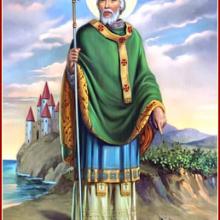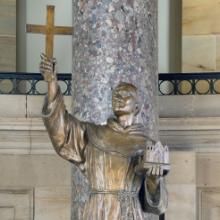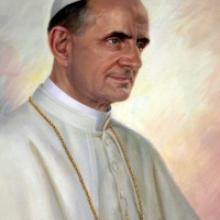sainthood
Did you know jazz musician John Coltrane was canonized by the African Orthodox Church in 1982? Coltrane was canonized at the behest of a religious community in San Francisco which founded a church in his name, and St. John Coltrane Church is still alive and well today.
The announcement follows past pushback by previous conservative popes who disapproved of Romero's leftist political views and liberation theology.

Image via REUTERS/Alessandro Bianchi/RNS
Pope Francis has approved new rules to tighten financial oversight of the canonization process after leaked documents revealed abuses and high costs in creating saints. The new measures focus on how the Holy See handles applications for sainthood, which can be a lengthy and expensive process that involves examining claims made by supporters of a would-be saint.
The Vatican has announced that Pope Francis will canonize Mother Teresa in September 2016, according to Gerard O’Connell with America magazine.
Known for her zealous commitment to serving the poor, Teresa of Calcutta’s beatification process was one of the shortest in modern history, and was completed on Oct. 19, 2003, by Pope John Paul II — just six years after she died in 1997.
Central America needs help expanding education opportunities, building child welfare systems, and sheltering victims of violence and witnesses to crime. But none of these reforms can be sustained unless Central American governments also work to eradicate corruption and reform their judicial systems.
As Romero said during a time of similar urgency, “On this point there is no possible neutrality. We either serve the life of Salvadorans or we are accomplices in their death. … We either believe in a God of life or we serve the idols of death.”
Pope Francis will bestow sainthood on two Palestinian nuns on May 17, a move that’s being seen as giving hope to the conflict-wracked Middle East and shining the spotlight on the plight of Christians in the region.
Sisters Maria Baouardy and Mary Alphonsine Danil Ghattas are due to be canonized by the pontiff along with two other 19th-century nuns, Sister Jeanne Emilie de Villeneuve, from France, and Italian Sister Maria Cristina dell’Immacolata.
The coming canonizations have been described by the Latin patriarch of Jerusalem, Fouad Twal, as a “sign of hope” for the region.
For Catholics, Episcopalians and some Lutherans, March 17 is the Feast Day of St. Patrick. For the rest of us, it’s St. Patrick’s Day — a midweek excuse to party until we’re green in the face. But who was Patrick? Did he really drive the snakes out of Ireland or use the shamrock to explain the Trinity? Why should this fifth-century priest be remembered on this day?
Q: Was St. Patrick a real guy, and would he approve of green beer?
A: Yes, Patrick was a real person, but not much is known of his life. He was born in the late 300s when the Roman Empire extended to England, so he was not “really” Irish — like the vast majority of people who celebrate his day. In his “Confessio,” one of only two surviving documents attributed to him, Patrick wrote that while his father was a Christian deacon, he was not devout. At age 16, Patrick was captured by Irish marauders, carried across the Irish Sea and enslaved. Patrick spent six years alone in the wilderness tending his master’s sheep, praying constantly. “It was among foreigners that it was seen how little I was,” he wrote. He began to have visions and hear voices that told him: “Look, your ship is ready.” So Patrick left his first flock and walked 200 miles to the coast. It’s a pretty safe bet he would have loved a beer, green or otherwise, as he stepped into a boat bound for England.
Junipero Serra, the 18th-century Franciscan missionary who’s set to be declared a saint later this year despite protests from Native American groups, could lose his place of honor in the U.S. Capitol if a California lawmaker has his way.
State Sen. Ricardo Lara, an openly gay Los Angeles Democrat, wants to replace a bronze statue of Serra with a monument honoring the late Sally Ride, the nation’s first female astronaut. Lara said Ride would become “the first member of the LGBT community” to be honored in Statuary Hall.
Each state is allowed two statues to represent local heroes; California’s other statue is of former President Ronald Reagan, who joined the collection in 2009, replacing a monument to itinerant preacher Thomas Starr King. The King and Serra statues were added in 1931.
“Dr. Sally Ride is a California native, American hero and stratospheric trailblazer who devoted her life to pushing the limits of space and inspiring young girls to succeed in math and science careers,” Lara said in a statement.
“She is the embodiment of the American dream.”
Archbishop Oscar Romero, the hero of the Catholic left who was assassinated in 1980 while celebrating Mass in El Salvador, is inching one step closer to sainthood after his case languished in bureaucratic limbo for decades.
According to the Italian Catholic bishops daily, Avvenire, a panel of theologians at the Congregation for the Causes of Saints has ruled unanimously that Romero should be considered a martyr, or murdered “in odium fidei” (Latin for “hatred of faith”).
The paper reported the ruling was made on Jan. 7. The move is considered a decisive step on Romero’s path to sainthood.
Romero, the archbishop of San Salvador, was shot dead by right-wing death squads while celebrating Mass in March 1980. His murder came a day after he delivered a homily calling for soldiers to lay down their guns and end government repression in the country’s bloody civil war.
As he wraps up a Vatican meeting marked by sharp debates over sex and morality, Pope Francis on Oct. 19 will honor one of his most controversial predecessors by beatifying Pope Paul VI, who is most famous for reaffirming the Catholic Church’s ban on artificial contraception.
Beatification puts Paul one step shy of formal sainthood. The move might seem out of step with Francis’ pastoral approach given that Paul’s birth control ruling, in the 1968 encyclical “Humanae Vitae,” set the stage for the culture wars that overtook Catholicism after Paul died in 1978.
A wide swath of Catholics, especially in the U.S. and Europe, were furious over Paul’s decision. They were convinced that the ban would be lifted and that Paul was shutting down the reforms that had begun a few years earlier with momentous changes adopted by the Second Vatican Council.
Many conservatives, on the other hand, hailed “Humanae Vitae” for reasserting traditional doctrine, and the division foreshadowed the deep splits that have played out even in this month’s high-level synod in Rome — a polarization that Francis says he wants to overcome.
Yet Francis is trying to accomplish that goal by focusing not so much on “Humanae Vitae” but on Paul VI’s many other groundbreaking, though often overlooked, contributions:
From the moment news broke that U.S. journalist James Foley had been beheaded by Islamic State extremists in the Middle East, many Christians, especially Foley’s fellow Catholics, began calling him a martyr, with some even saying he should be considered a saint.
Yet that characterization has left others uneasy, and the discussion is raising larger questions about what constitutes martyrdom.
Foley’s parents seemed to validate the martyrdom label when his father, John, spoke at an emotional news conference outside the family’s New Hampshire home and said he and his wife “believe he was a martyr.” Foley’s mother, Diane, added that her son “reminds us of Jesus. Jesus was goodness, love — and Jim was becoming more and more that.”
In an interview two days later with Katie Couric, Foley’s younger brother, Michael, recounted how Pope Francis had called the family to console them and in their conversation “referred to Jim’s act as, really, martyrdom.”
Numerous commentators had already picked up on that idea, holding Foley up not only as a witness to the Christian faith but as a spur for believers in the West to take more seriously the plight of Christians in Iraq and elsewhere in the Middle East who are being persecuted to a degree that some say is comparable to genocide.
But in the Catholic Church, determining whether someone is a martyr is not so easy. Historically, two conditions must be met.
Despite fevered speculation in the media and across Latin America, the Vatican says Pope Francis has not advanced slain Salvadoran Archbishop Oscar Romero toward sainthood — at least, not yet.
Pope John Paul II gave him the title “servant of God” in 1997 and the case for his canonization began. But the case stalled under the papacy of Benedict XVI over concerns that Romero was too close to the liberation theology that John Paul and Benedict spent years trying to repress.
Francis revived the cause soon after he was elected last year, and recent reports in several languages have suggested that church officials were poised to beatify Romero, putting him one step short of sainthood.
This weekend, more than 800,000 spectators crowded the St. Peter’s Square area while 500,000 more watched on giant screens around Rome as Pope Francis canonized Pope John XXIII and Pope John Paul II. The first time a pope has sainted two popes at the same time, this historic event has been called a savvy political move by the media, since Pope Francis recognized both the more liberal John XXIII and the more conservative John Paul II, thus satisfying two opposing wings of the Roman Catholic church. While Pope Francis did indeed display political savvy at this canonization, this event holds far more significance than that (even leaving aside the spiritual question of discerning sainthood).
When Pope Francis canonizes Popes John XXIII and John Paul II on Sunday, Catholics across the spectrum will have reason to cheer: Liberals credit John with opening the church to the modern world in the 1960s, and conservatives hail John Paul as reasserting orthodoxy after too many innovations.
But the unprecedented double-barreled canonization also raises a question that might give both sides pause: Why is Rome making saints of almost every modern pontiff after nearly a millennium when almost no popes were canonized?
In the first 500 years of Christianity, the Apostle Peter (considered the first pope by tradition) and 47 of his 48 papal successors were viewed as saints, mainly because so many of them were martyred, which is the simplest route to canonization. Another 30 popes were named saints in the next 500 years, largely based on their reputation for sanctity.
Hundreds of pilgrims wind their way around St. Peter’s Square as tour guides shout in multiple languages. Beggars have their hands outstretched amid warnings of an invasion of pickpockets from abroad.
Italian authorities are expecting at least a million pilgrims, including heads of state, prime ministers, and diplomats from 54 countries. One group of Polish pilgrims is making the 2,000-mile trek on horseback, dressed in medieval costumes, to celebrate Poland’s most famous native son.
Pope John Paul II won’t officially become a saint until a special high-profile ceremony next month at the Vatican. But the man who succeeded him says he has seen him in that light for years.
The Polish pontiff “did not ask for applause and never looked troubled when he was making difficult decisions,” Benedict said. “He acted in accord with his faith and beliefs, and he was willing to endure blows against him. I could and should not imitate him, but I did try to continue his legacy and his mission the best way I could.”
It’s almost a year since Pope Francis was chosen as Benedict XVI’s successor. The Argentinian-born pontiff has quickly achieved global fame for his numerous statements indicating that significant changes may be coming to the Roman Catholic Church.
One possible change emerged last month when London’s Sunday Times reported that Francis wants to make public the Vatican’s archives of Pius XII’s pontificate. Eugenio Pacelli became pope in 1939 and served as pontiff during the period of World War II and the Holocaust until his death in 1958.
According to the British newspaper, Francis wants to release the Pius XII papers for study before determining whether to consider his controversial predecessor for sainthood. Francis has already “fast-tracked” the path to sainthood for John XXIII and John Paul II, but not Pius XII.
Vatican theologians have given their approval to a miracle attributed to the intercession of Pope Paul VI, moving him a step closer to sainthood.
The team of medical professionals and doctors that advise the Vatican’s Congregation for the Causes of Saints already had approved the same miracle in December. Now that a panel of theologians has signed off, the miracle only requires a review by Pope Francis to be considered official.
When that happens, Paul will be beatified — the final step before sainthood. A second miracle is typically required for canonization.
A vial containing the blood of the late Pope John Paul II was stolen from a village church in a mountainous area east of Rome, sparking a regionwide manhunt that includes more than 50 police and a team of dogs specialized in tracking.
It is not clear when the break-in at the small Church of San Pietro della Lenca in the region of Abruzzo took place, but it was discovered by a church custodian on Sunday. The thief or thieves made off with a large crucifix and a gold reliquary containing the vial of the blood of John Paul, who will be proclaimed a saint in April.
Once John Paul is elevated to sainthood, artifacts from his life will increase in value.
Vatican officials say they expect next year’s celebration for the canonizations of former popes John Paul II and John XXIII to be attended by as many as 100 heads of state in what is likely to be the biggest draw to the city since John Paul’s funeral in 2005.
The crowd estimates were made Tuesday, the feast day for John Paul. This will be the last time he will be venerated as Blessed Pope John Paul II; after the canonization ceremony on April 27, 2014, he will be known as St. Pope John Paul II.
John Paul’s 2005 funeral may have been the single largest gathering in Christian history, with estimates as high as 4 million mourners gathered in the Italian capital, along with at least 80 presidents, prime ministers, and monarchs.


















